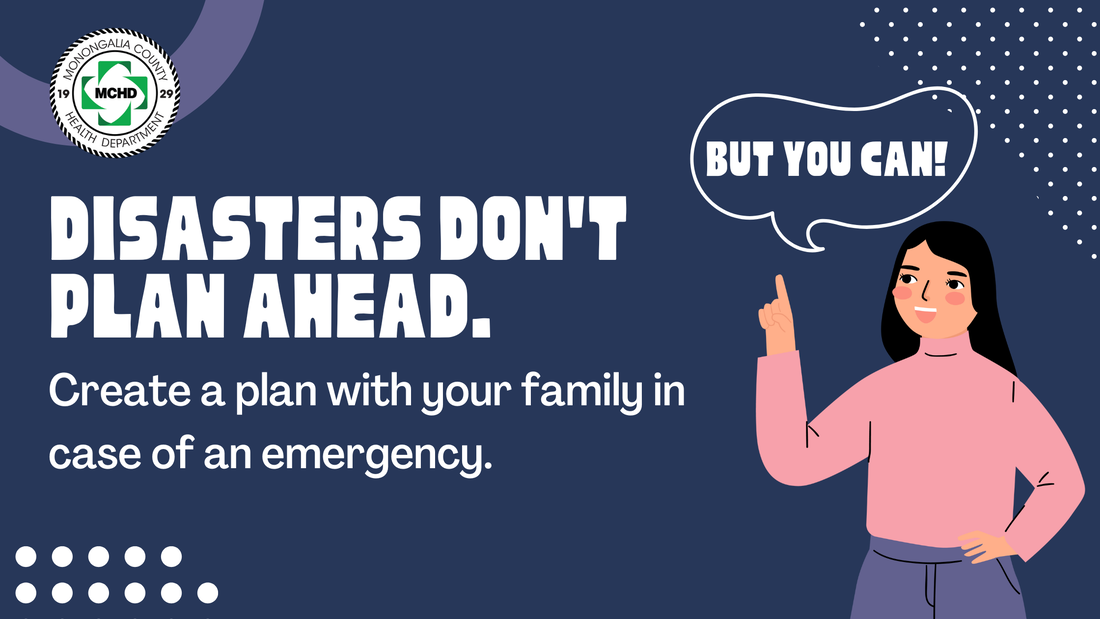Disasters don't plan, but you can

Sep. 14, 2022
By Mary Wade Burnside
Three years after the Sept. 11, 2001 terrorist attacks on the United States, September’s National Preparedness Month was established by the Federal Emergency Management Agency (FEMA).
Preparedness became an important goal after the attacks, and the creation Monongalia County Health Department’s Threat Preparedness program was also in response to the lives lost and destruction that took place after hijacked planes were flown into the World Trade Center’s twin towers in New York City and the Pentagon outside of Washington, D.C.
MCHD Threat Preparedness employees train to be ready to respond to any kind of situation, whether caused by what we call “a bad actor” with a gun or a dirty bomb or a natural disaster such as a tornado or flooding.
There is another important component to preparedness – everyone else. MCHD Threat Preparedness collaborates with local, state and federal partners in order to be ready to provide services when necessary and also conducts a variety of trainings to volunteers as well as citizens.
But it’s important to realize that individual community members can do a lot in order to help themselves, their families and even their neighbors.
Unfortunately, these days, it’s not much of a hard sell to convince anyone that at times, at the very least, there will be area residents dealing with power outages from storms and maybe even some household flooding.
It’s been 10 years since the derecho that hit West Virginia hard left some without electricity for days or even a week or longer. If that happened to you, how would you cope? And in more recent years, areas of Morgantown have experienced flash floods; the devastating flooding in Kentucky recently also hits close to home.
Ready.gov, FEMA’s preparedness site, encourages you to make a kit to be ready for those
types of incidents and more. You can refer to the website to see a list of practical items to
gather.
Other suggestions include:
- Learn how to receive emergency alerts.
- Make plans for both sheltering in place and also evacuation.
- Create a communication plan with your family in case disaster strikes when you are at different locations.
There are also financial preparations you can make to better help in the event of an emergency.
- Keep financial, critical household and medical information handy, including printed copies.
- Purchase homeowners or renters insurance, as well as health and life insurance if you don’t have them.
- Consider saving money in an emergency savings account that could be used in any crisis. Keep a small amount of cash at home in a safe place. It is important to have small bills on hand because ATMs and credit cards may not work during a disaster when you need to purchase necessary supplies, fuel or food. Remember, homeowners insurance typically doesn’t cover flooding, so if you believe this is a risk to your property, look into flood insurance.
Additionally, so many people are pet owners and you don’t want to forget about your furry (or scaly) family members. Microchipping dogs and cats will aid in them being reunited with you more easily.
You also might want to make a plan with your neighbors, including those with pets who can serve as an evacuation backup in case you are gone, and vice versa. But getting to know your neighbors is also a good idea in general, because you can help each other out and check on the elderly and others who might need assistance when an incident occurs.
MCHD Threat Preparedness also provides a variety of training that you can schedule now, including Stop the Bleed, a national program that can be used if someone is injured in a car accident, a shooting or in some other way. To schedule a training, email Joseph.L.Klass@wv.gov.
Disasters aren’t fun to think about but being prepared makes them easier to handle when something happens.
Mary Wade Burnside is the public information officer at Monongalia County Health Department.